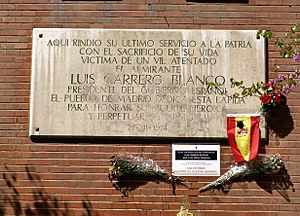Assassination of Luis Carrero Blanco facts for kids
Quick facts for kids Assassination of Luis Carrero Blanco |
|
|---|---|
| Part of the Basque conflict | |
| Location | Madrid, Spain |
| Date | 20 December 1973 9:36 a.m. (CST) |
| Target | Luis Carrero Blanco |
|
Attack type
|
Car bombing |
| Deaths | 3 |
| Perpetrators | ETA |
The assassination of Prime Minister Luis Carrero Blanco was a major event in Spain's history. It is also known by its secret name, Operación Ogro (which means "Operation Ogre"). Admiral Luis Carrero Blanco was killed in Madrid by a group called ETA on December 20, 1973.
At the time, Spain was ruled by a dictator named Francisco Franco. This assassination was seen as the biggest attack against Franco's government since the Spanish Civil War ended in 1939.
Carrero Blanco's death had many important political effects. By late 1973, dictator Franco was very old and sick. Carrero Blanco's death showed that Franco's government was facing its final challenges. After he died, some very conservative people in Franco's government, known as the búnker, wanted Franco to choose someone like them as the new Prime Minister. Franco chose Carlos Arias Navarro. He first said he would make some changes, but then he went back on his word because of pressure from the búnker.
Meanwhile, ETA became a very important armed group. They grew to be one of the main groups fighting against Franco's rule.
The Attack
An ETA team, using the code name Txikia, rented a basement apartment in Madrid. This apartment was on the street where Carrero Blanco regularly drove to church. Txikia was the nickname of an ETA activist who had been killed earlier that year.
For five months, the ETA team dug a tunnel under the street. They told their landlord they were student sculptors to hide what they were really doing. They filled the tunnel with 80 kilograms (about 176 pounds) of Goma-2, a type of explosive. This explosive had been stolen from a government storage place.
On December 20, 1973, at 9:36 AM, three ETA members dressed as electricians set off the explosives. They did this as Carrero Blanco's car, a Dodge Dart, drove over the tunnel. The explosion was so powerful that it threw Blanco and his car 20 meters (about 65 feet) into the air. The car flew over a five-story church and landed on a second-floor terrace on the other side of the street.
Carrero Blanco survived the blast at first but died in the hospital at 10:15 AM. His bodyguard and driver also died soon after. The "electricians" quickly told shocked people nearby that it was a gas explosion. Then they ran away in the confusion. ETA officially said they were responsible for the attack on January 22, 1974.
Later, the ETA bombers explained why they did it. They said Carrero Blanco had been in charge of the government since 1951. They believed he represented "pure Francoism" and was secretly trying to give more power to a group called Opus Dei. They saw him as a very powerful person who had created his own network of spies within the government and army. They felt he was key to keeping Franco's system going and was hard to replace.
Many people who were against Franco's government, especially those living outside Spain, did not condemn the killing. Some even welcomed it. Some experts believe that this assassination was the only thing ETA ever did that helped Spain become a democracy. However, a former ETA member named Jon Juaristi said that ETA's real goal was not democracy. He thought they wanted to cause more violence and make Franco's government crack down harder on Basque people. This, he believed, would force Basque citizens to support ETA against Franco.
Reaction
A government meeting was planned for December 20, 1973, to discuss "dangers to Spain." Both Carrero Blanco and the United States Secretary of State, Henry Kissinger, had talked about concerns over a left-wing uprising the day before. When government officials arrived at the Palace of Villamejor for the meeting, they learned that Carrero Blanco had died.
The Deputy Prime Minister, Torcuato Fernández Miranda, asked everyone to stay calm. He announced that he would call Franco to find out what to do next. After the call, Fernández Miranda declared himself prime minister. This was allowed by the laws of the country. His first decision was not to declare a "state of emergency."
The Minister of the Navy, Gabriel Pita da Veiga, told Fernández Miranda that the head of the Civil Guard (Spain's police force) had ordered his officers to use deadly force if there were any clashes. But Fernández Miranda disagreed. He immediately made the Civil Guard chief cancel that order.
See also
 In Spanish: Asesinato de Carrero Blanco para niños
In Spanish: Asesinato de Carrero Blanco para niños
- Cassandra case, a student who was charged for making jokes about the assassination of Luis Carrero Blanco on social media.
- Operación Ogro, a movie about the attack made by Gillo Pontecorvo.
- The Last Circus, a movie where the attack is a small part of the story.


